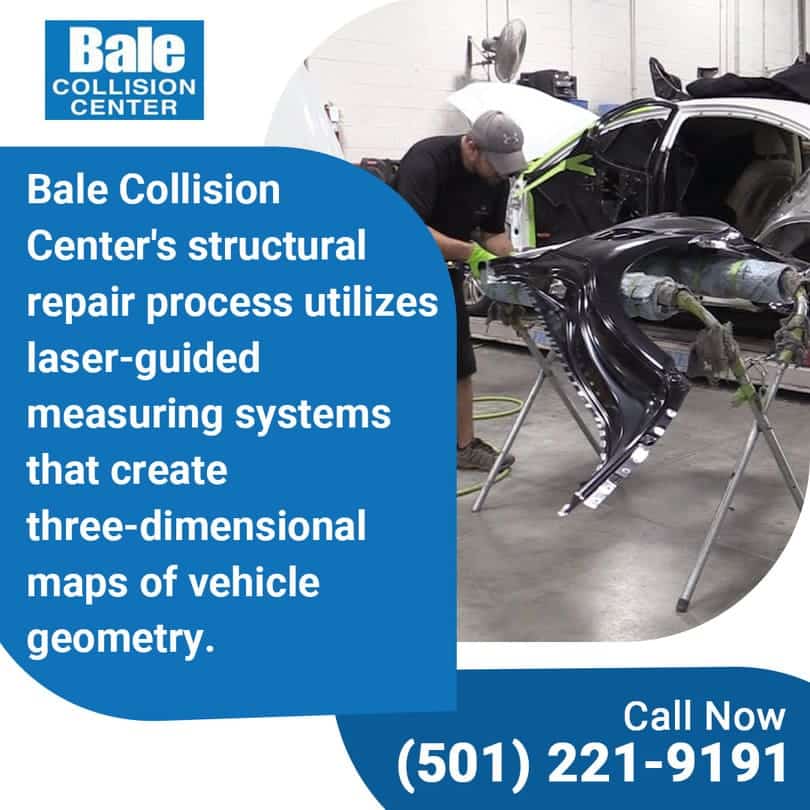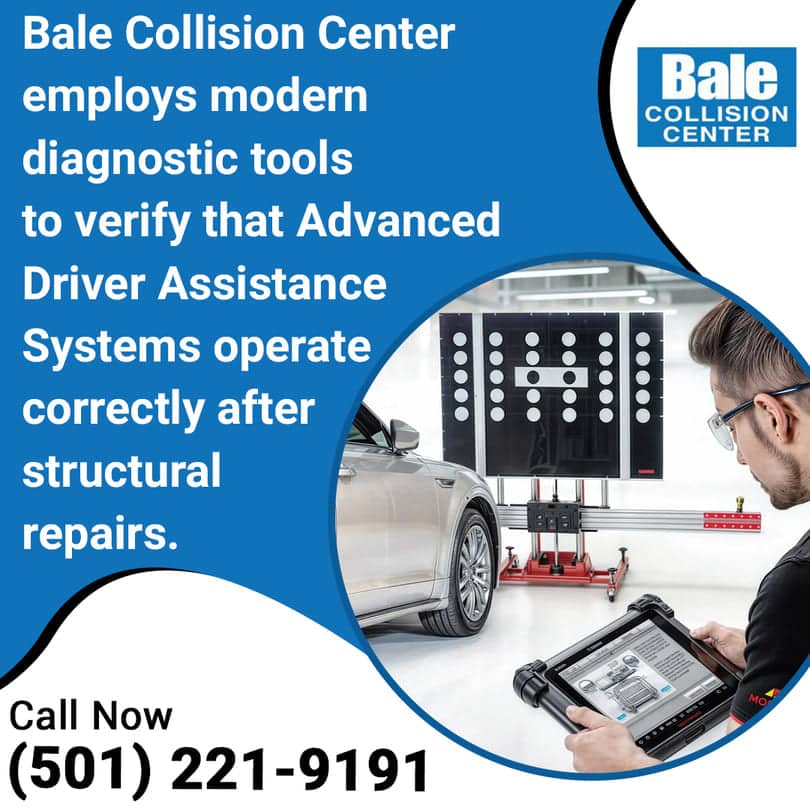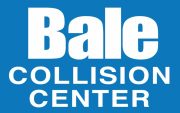When collision damage affects your car’s frame or structure, the repair process becomes much more complex than fixing a dented bumper or scratched door. Understanding why structural repairs demand specialized knowledge, equipment, and techniques can help you make informed decisions about your vehicle’s restoration.
At Bale Collision Center, we’ve spent over 70 years perfecting auto collision repair techniques that restore both safety and performance. Our I-CAR Platinum-certified technicians use advanced equipment and follow strict manufacturer procedures to make sure your vehicle provides the same protection it did before the accident. We know that proper structural work is about preserving the engineering that keeps you safe.

What Makes Structural Damage Different
Your Vehicle’s Hidden Protection System
Just like the bones in your body support your muscles and organs, your vehicle’s frame supports everything else while protecting you during crashes. This structural framework stays hidden beneath your car’s exterior panels, yet it continuously protects you while you drive.
Modern vehicles use what engineers call “crumple zones”, which are areas designed to fold and absorb crash energy before it reaches you. These zones work together with a strong passenger compartment that acts like a protective cage around the seating area. When structural damage occurs, this carefully designed protection system can be compromised.
Why Frame Damage Spreads Throughout the Vehicle
When your car hits something or gets hit, the impact forces travel through connected metal parts. What starts as damage in one area can affect parts of the vehicle that seem completely unrelated to the crash.
For example, a front-end collision might bend the frame rails that run under your car. This bending can throw off your wheel alignment, affect how your doors close, and even impact the mounting points for your seat belts and airbags. Without proper structural repair, these hidden problems can create safety risks and cause parts to wear out faster than normal.
Our collision repair technicians at Bale Collision Center understand these connection patterns. We trace the impact forces throughout the structure to find every area that needs attention.
The Technology Behind Modern Structural Repair
Precision Measurement Systems Make All the Difference
Today, professional collision centers use laser-guided measuring systems that can detect problems invisible to the naked eye. At Bale Collision Center, we use Car-o-Liner measuring equipment to create a three-dimensional map of your vehicle’s current shape and compare it to the original factory specifications. This technology can spot frame problems measured in millimeters, but significant enough to affect safety and performance.
These measurements guide every step of the car collision repair process. Instead of guessing where to apply force or how much pressure to use, our technicians follow precise data that tells them exactly how to restore your vehicle’s original geometry.
Advanced Equipment Does What Hand Tools Cannot
The hydraulic frame machines used for structural repair can apply thousands of pounds of force with precise control. It’s carefully calculated engineering that reverses crash damage without creating new problems.
Modern frame equipment can pull from multiple directions simultaneously while continuously monitoring progress. This capability allows repairs that would be impossible with older methods. The machines can straighten bent frame rails, realign suspension mounting points, and restore door frame geometry, all while maintaining factory specifications.
Material Science and Structural Integrity
Different Steel Types Require Different Approaches
Modern vehicles use several different grades of steel in various locations. High-strength steel provides maximum protection in critical areas, while softer steel allows controlled deformation in crumple zones.
Each steel type responds differently to repair processes. Ultra-high-strength steel can become weaker if heated improperly during collision repair. Regular steel might stretch beyond its elastic limit if pulled too aggressively. Our certified technicians understand these material properties and adjust their techniques accordingly.
This knowledge prevents repairs that look correct but are actually weaker than the original structure. Using the wrong collision repair approach can turn a protective steel component into a weak point that could fail during another accident.
Welding Technology That Matches Factory Standards
When structural components need replacement, the welding process becomes critical for maintaining strength and safety. Factory welds are created under controlled conditions using specific techniques, materials, and quality standards.
At Bale Collision Center, we use Pro-Spot welding equipment that replicates these factory conditions as closely as possible. The machines control heat input, penetration depth, and cooling rates to create welds that match the original strength. This attention to welding quality ensures that repaired joints will perform as intended during future impacts.
Why Manufacturer Procedures Matter
Engineering Specifications Aren’t Suggestions
Vehicle manufacturers spend millions of dollars and countless hours developing car collision repair procedures for their products. These Original Equipment Manufacturer (OEM) specifications are requirements for maintaining the safety and performance characteristics built into your vehicle.
OEM procedures specify everything from which welding techniques to use on specific steel types to how much force can be safely applied during straightening operations. They account for factors like material properties, joint locations, and interaction with safety systems that might not be obvious during repair.
Following these procedures means your repaired vehicle maintains the protection levels intended by the engineers who designed it. Cutting corners or using generic auto collision repair approaches can compromise this engineered protection.
Parts Quality Affects Long-Term Performance
The parts used in structural repair directly impact both safety and durability. OEM structural components undergo extensive testing to verify they meet crash performance standards. They’re designed to work with specific materials, fit precise dimensions, and integrate properly with safety systems.
Aftermarket structural parts might save money initially, but they may not provide the same level of protection or longevity. For critical safety components, the small cost difference between OEM and aftermarket parts is insignificant compared to the potential safety implications.
Modern Safety System Integration
How ADAS Systems Connect to Structure
Advanced Driver Assistance Systems (ADAS)like automatic emergency braking, lane keeping assistance, and adaptive cruise control rely on sensors mounted throughout the vehicle. These sensors must maintain precise positions and angles to function correctly.
Structural damage can shift sensor mounting points by small amounts that don’t affect vehicle appearance but impact system performance. For example, when a camera’s position is off by just a few degrees, it might not detect lane markings properly. A radar sensor that’s misaligned could fail to identify approaching obstacles.
Professional structural repair includes checking and recalibrating these systems after completing the framework. We use VSSTA diagnostic equipment at our collision center to verify that all safety systems operate correctly with the restored structure.
Airbag System Considerations
Airbag deployment timing depends on crash sensors distributed throughout the vehicle structure. These sensors detect impact forces and signal the airbag control module when deployment is necessary. Structural damage can affect sensor positioning and response characteristics.
During structural repair, these sensors and their mounting points require careful inspection and testing. Changes in structure geometry can alter how crash forces reach the sensors, potentially affecting airbag timing. Our car collision repair technicians verify that all crash sensors operate within specifications after completing structural restoration.
The Insurance and Value Protection Angle
Documented Quality Protects Resale Value
Vehicles with collision history often face reduced resale values, but professional auto collision repair with proper documentation can minimize this impact. Insurance companies and potential buyers have more confidence in repairs performed to OEM standards using quality parts and procedures.
At Bale Collision Center, we provide detailed documentation of all repair procedures, parts used, and quality checks performed. This paperwork demonstrates that your vehicle received professional restoration rather than quick fixes. The documentation can be valuable when selling or trading your vehicle years later.
Working With Insurance Companies
Most insurance companies recognize the importance of proper structural repair and will authorize necessary procedures when presented with clear explanations of safety requirements. Our experience working with all insurance providers helps streamline the approval process for structural repair work.
We handle the communication with insurance adjusters, explaining why specific procedures and parts are necessary for safe restoration. This advocacy helps you receive appropriate coverage for proper car collision repairs rather than shortcuts that compromise safety.
Choosing the Right Collision Repair Facility in Little Rock, AR
Certifications That Demonstrate Competence
Not all collision centers have the training, equipment, or certification necessary for quality structural work. I-CAR certification represents the industry standard for collision repair knowledge, with different levels indicating various skill levels.
I-CAR Gold Class certification applies to collision centers that demonstrate extensive capabilities and ongoing training. I-CAR Platinum certification for individual technicians represents the highest level of personal expertise. These certifications indicate a serious commitment to professional repair standards.
At Bale Collision Center, we hold I-CAR Gold Class certification, and our technicians maintain I-CAR Platinum status through continuous education and training. This combination provides assurance that both our facility and our personnel meet the most demanding professional standards for certified collision repair in Chenal, Little Rock, AR.
Equipment Investment Reflects Commitment
Professional structural repair requires significant investment in specialized equipment. Frame machines, measuring systems, welding equipment, and diagnostic tools represent hundreds of thousands of dollars in capital investment.
Shops that make these investments demonstrate a long-term commitment to quality structural repair. The equipment requires ongoing calibration, maintenance, and operator training to remain effective. This level of investment and maintenance indicates a serious approach to professional collision repair.

The Bale Collision Center Approach
Experience Spanning Automotive Evolution
Our 72 years in business have given us perspective on how collision repair has evolved from simple metalwork to sophisticated engineering restoration. We’ve adapted our methods and equipment while maintaining our commitment to safety and quality throughout these changes.
We understand how different vehicle designs respond to various types of impact and what repair approaches work best for different situations. Our experience, combined with modern equipment and training, provides a unique advantage for high-quality certified collision repair in Chenal, Little Rock, AR.
Community Trust and Long-Term Relationships
Serving Little Rock since 1952, we have built deep trust within the community through consistent quality and exceptional service. Generations of families have relied on us for their collision repair needs, creating relationships that span decades.
Our customers regularly share their positive experiences, like this recent review: “I absolutely love Bale. Courteous and exact in their work. Betty is absolutely wonderful. Not only is she wonderful to interact with, but she is spot on with her estimates. I have now come to them 4 times. They even have a new system that texts you information on the status of your repair with a link that gives more information. Definitely a strong suggestion to me. If you’re in a collision, it is difficult to find better.”
Customers return for subsequent repairs, refer family members, and share feedback about vehicle performance years after collision repair. This accountability encourages us to maintain the highest standards in every repair.
Modern Technology and Training
Our investment in modern technology, including car-o-liner frame equipment, Pro-Spot welding systems, and VSSTA diagnostic tools, reflects our commitment to staying current with repair technology. These tools enable auto collision repairs that match or exceed factory standards while providing the precision necessary for modern vehicle restoration.
Automotive technology continues evolving rapidly, requiring constant education to maintain competency. Our technicians undergo training programs to stay up-to-date with the current technology. This keeps our team equipped to handle the latest vehicle designs and repair challenges.
Making the Right Choice for Your Safety
When your vehicle needs structural collision repair that prioritizes safety over shortcuts, trust the certified professionals at Bale Collision Center. Contact us at (501) 221-9191 or bccwlr@baleautomotive.comfor thorough damage assessment and expert restoration using advanced equipment and OEM procedures. Our certified technicians provide expert certified collision repair in Chenal, Little Rock, AR, that prioritizes your safety above everything else.
